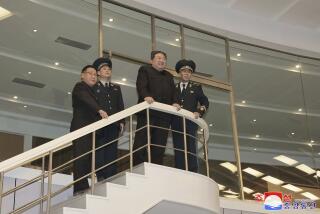When Satellites Look Down on Us, They Offer Good Options as Well as Bad
- Share via
The mission of the space shuttle Discovery and the deployment of its satellite cargo underscores the resiliency and professionalism of America’s space program. At present, only the superpowers can conduct manned missions, but satellite launching is within the capability of a growing list of states, including France, China, Japan, India and Israel. Others may join the club, and for good reason: Satellite technology has far-reaching implications for international security. The diffusion of this technology has already changed the way nations, intelligence agencies and the media operate.
Satellites allow nations to communicate better and learn more about their neighbors, the global environment and the universe. They can be used to exploit natural resources or to target opposing military facilities. The technology itself is value-neutral; it can be used for offensive or peacekeeping purposes.
Satellites that take pictures of Earth are a source of special fascination, in part because their highly detailed images have been kept secret from all but a select few. France opened this closed shop with its 1986 launch of SPOT, a commercial satellite whose pictures are available for sale. Objects less than 30 feet across may not show up on SPOT pictures, which makes them far inferior to images generated by American photoreconnaissance satellites whose resolution is measured in inches. Nevertheless, SPOT’s images have already been newsworthy, and they will have more of an impact as sharper images become available for sale with shorter delays.
Commercial satellite photography has helped open up the Soviet Union, reinforcing Mikhail S. Gorbachev’s policy of glasnost. Pictures from space of the Chernobyl accident made a mockery of antiquated Kremlin news-management policies. The world also learned more about sensitive Soviet military installations after satellite images of them were shown on the evening news in the West. In the case of the illegal radar station near Krasnoyarsk, SPOT images may well have helped pave the way for an American congressional delegation to visit the site.
Greater openness is a two-way street, however. The Kremlin is offering for sale pictures that should be twice as sharp as those provided by SPOT. If pictures of nuclear and chemical weapons storage sites in Western Europe were distributed to the media, they could create political controversies for NATO members and dissension within the alliance. Pictures of large military installations or weapon systems could be useful for anyone with an ax to grind over the issue of arms-control compliance. Decision-makers could be subjected to intense political pressures during crises as a result of inflammatory pictures purchased by the media.
As more countries utilize pictures from space, intelligence agencies will be increasingly affected. Commercial satellites now enable countries to be less dependent on outside information. As higher-quality pictures become commercially available, pressures will mount for release of classified photographs, as well as information about sources and methods of intelligence collection.
These emerging trends were evident in the U.S.-West German dispute over the Libyan chemical facility. The West German government used SPOT imagery to observe the plant, initially resisting U.S. claims about German industry participation. Washington then decided to make more detailed information privately available, including pictures from photoreconnaissance satellites. Still, the West German government dragged its feet, until SPOT pictures of the Libyan facility appeared in the media.
Satellites will play an increasing role in future military conflicts. Overhead surveillance of any kind makes it harder to launch surprise attacks. But commercial satellites can also provide useful targeting information, especially for mapping penetration routes to heavily defended installations. Countries with an interest in making the most effective use of their advanced aircraft and cruise missiles will acquire satellite data; other states will feel the need to take matching steps.
Commercial satellite photography has already proven to be useful for conducting broad area surveillance over countries beyond the reach of reconnaissance aircraft, and for detecting important changes over time, such as lengthened runways and large military construction projects. This information can intensify reconciliation efforts, defuse crises based on misunderstandings, or help nations prepare offensive strikes and countermeasures.
The Iran-Iraq war provided a glimpse of how states might use satellite data in future cross-border conflicts. Commercially available images showed the installation of Silkworm missiles, the construction of artificial water barriers against ground attack and damage to refineries by air power. Because SPOT maintains confidentiality about its customers, we do not know whether the combatants utilized these pictures; we do know that both took steps to acquire computers designed to enhance satellite data.
As more countries launch their own imaging satellites or tap into commercial ventures, domestic critics, foreign competition and the media will have one more club to use against political leaders. But national leaders will also have access to new tools that can be used for peacekeeping and environmental protection.
The challenge in the years ahead is to make the most of the benefits that can accrue from the spread of satellite technology, and to devise safeguards against mischief-making.
More to Read
Sign up for Essential California
The most important California stories and recommendations in your inbox every morning.
You may occasionally receive promotional content from the Los Angeles Times.













